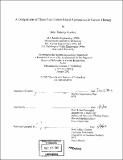| dc.contributor.advisor | Robert Zamenhof. | en_US |
| dc.contributor.author | Goorley, John Timothy, 1974- | en_US |
| dc.contributor.other | Massachusetts Institute of Technology. Dept. of Nuclear Engineering. | en_US |
| dc.date.accessioned | 2006-03-24T18:10:42Z | |
| dc.date.available | 2006-03-24T18:10:42Z | |
| dc.date.copyright | 2002 | en_US |
| dc.date.issued | 2002 | en_US |
| dc.identifier.uri | http://hdl.handle.net/1721.1/30001 | |
| dc.description | Thesis (Ph. D.)--Massachusetts Institute of Technology, Dept. of Nuclear Engineering, 2002. | en_US |
| dc.description | Also issued in pages. Vita. | en_US |
| dc.description | Includes bibliographical references. | en_US |
| dc.description.abstract | Some recent neutron capture therapy (NCT) research has focused on using compounds containing the element gadolinium (Gd), which produces internal conversion and Auger cascade electrons upon absorbing thermal neutrons. The low energy, nanometer-range, Auger electrons are absorbed locally and significantly increase cell killing when Gd binds to DNA. Two other methods induce Auger electrons in gadolinium isotopes: the beta decay of 159Gd, and K shell photoelectric events during photon irradiation. To determine the potential application that Auger cascades from these three processes could have in brain tumor therapy, macroscopic and microscopic radiation transport calculations were employed to relate peak brain dose to DNA double-strand breaks (DSBs) in tumor cells. Macroscopic calculations indicated that even optimal gadolinium distributions produce GdNCT and Gd photon activation therapy (PAT) dose distributions in brain tumors less favorable than those with boron-based NCT. 59Gd radionuclide therapy (RNT), however, produced more favorable dose distributions, assuming optimal tumor retention. Microscopic transport calculations superimposed Auger electron tracks over an atomistic model of mammalian chromatin fiber and tracked resulting OH, H, and eaq radicals to determine strand breaks. | en_US |
| dc.description.abstract | (cont.) Calculated DSBs from 125I, a well-studied Auger electron therapy isotope, were compared to similar calculational and experimental results to validate the code. The '57Gd(n,y), Gd photoelectric events and 59Gd decays result in 0.21, 0.25, and 0.05 DSBs per event, respectively. For concentrations of 1000 ppm Gd and a peak dose to brain of 10 Gy, the three gadolinium-based therapies produced up to 150 ± 30 Auger electron induced DSBs per tumor cell in midline tumors, depending on the tumor dose distribution and tumor size. Assuming that equal DNA damage from 125I decay and Gd Auger electrons result in similar cell survival, Gd Auger electrons in these three therapy modalities will have some cell killing potential of their own, indicating potential therapeutic application. | en_US |
| dc.description.statementofresponsibility | by John Timothy Goorley. | en_US |
| dc.format.extent | 296 leaves | en_US |
| dc.format.extent | 12050320 bytes | |
| dc.format.extent | 12050119 bytes | |
| dc.format.mimetype | application/pdf | |
| dc.format.mimetype | application/pdf | |
| dc.language.iso | eng | en_US |
| dc.publisher | Massachusetts Institute of Technology | en_US |
| dc.rights | M.I.T. theses are protected by copyright. They may be viewed from this source for any purpose, but reproduction or distribution in any format is prohibited without written permission. See provided URL for inquiries about permission. | en_US |
| dc.rights.uri | http://dspace.mit.edu/handle/1721.1/7582 | |
| dc.subject | Nuclear Engineering. | en_US |
| dc.title | A comparison of three gadolinium based approaches to cancer therapy | en_US |
| dc.type | Thesis | en_US |
| dc.description.degree | Ph.D. | en_US |
| dc.contributor.department | Massachusetts Institute of Technology. Department of Nuclear Engineering | en_US |
| dc.contributor.department | Massachusetts Institute of Technology. Department of Nuclear Science and Engineering | |
| dc.identifier.oclc | 55002907 | en_US |
